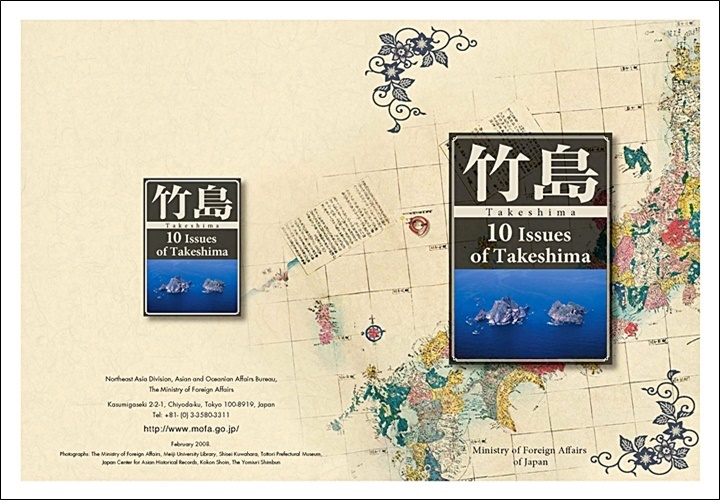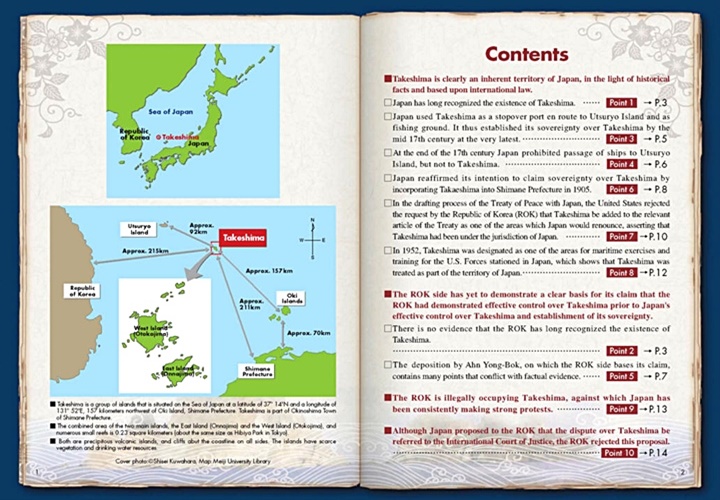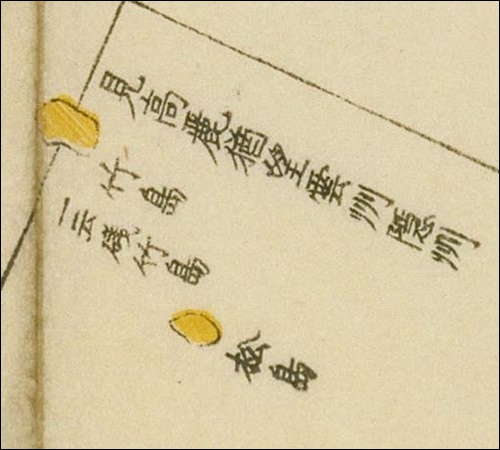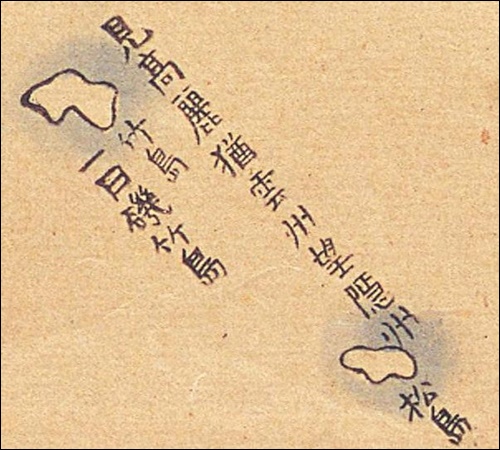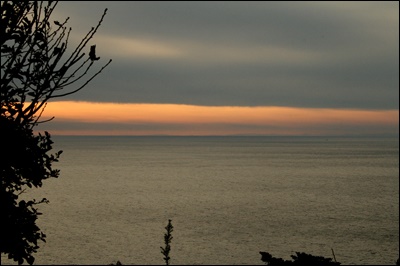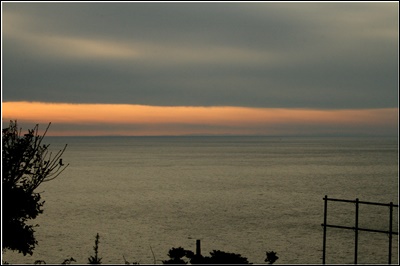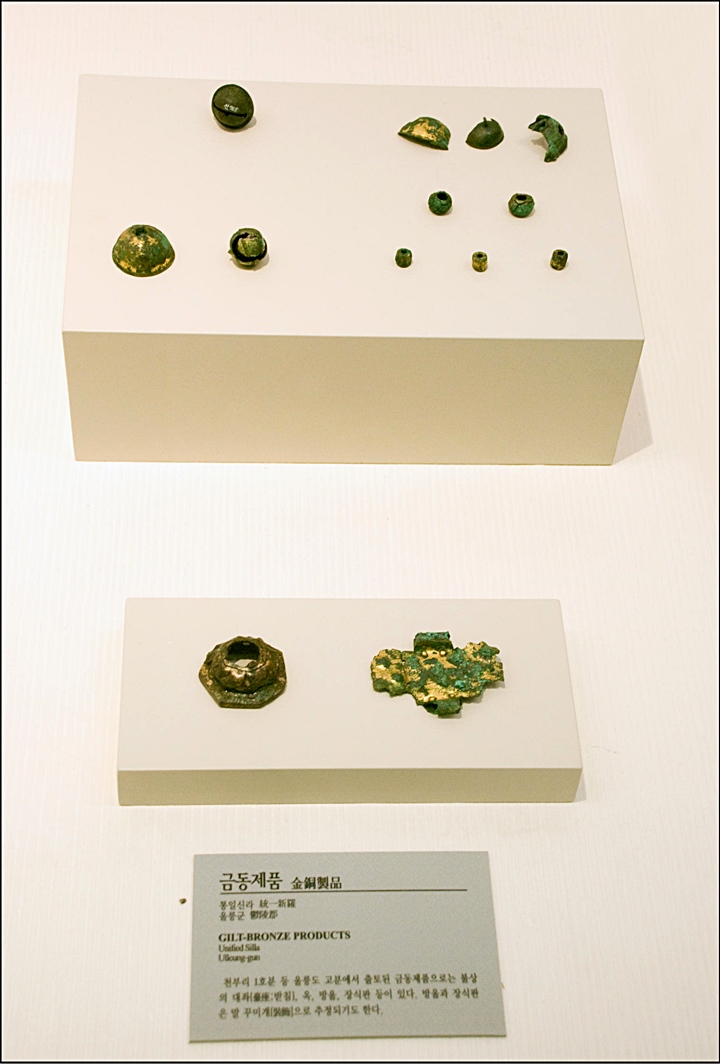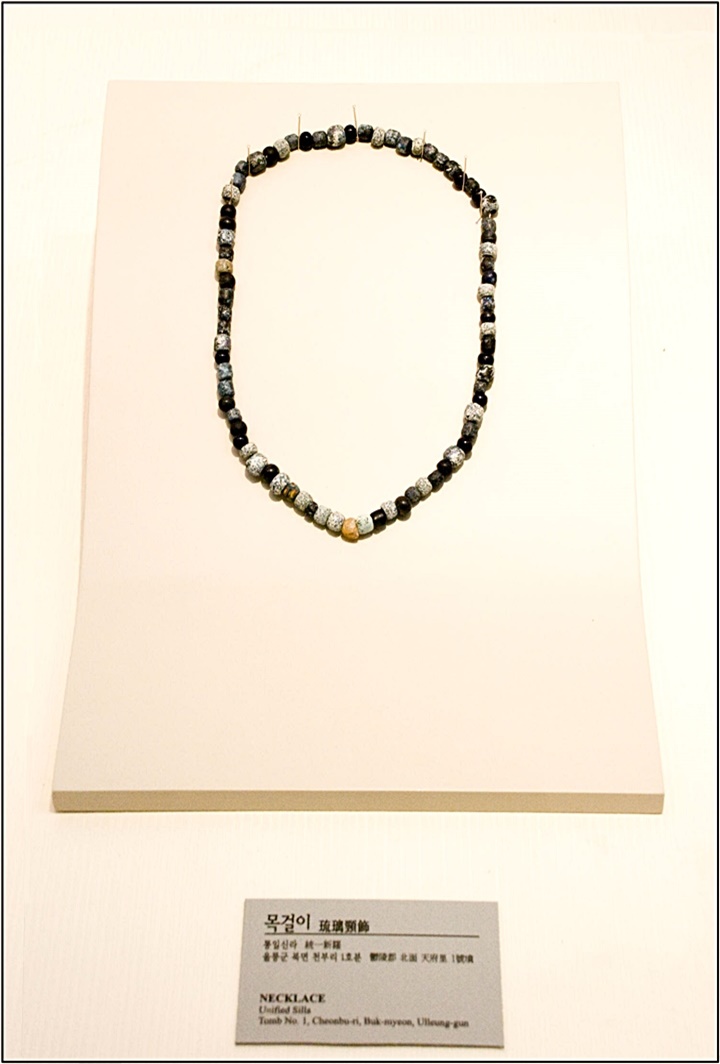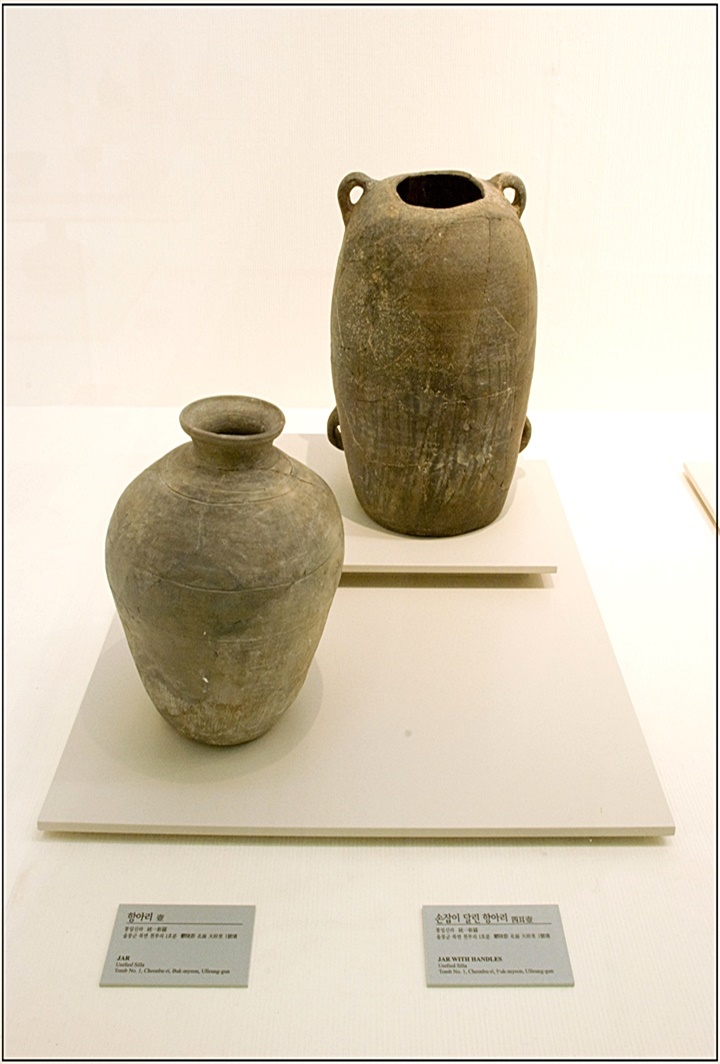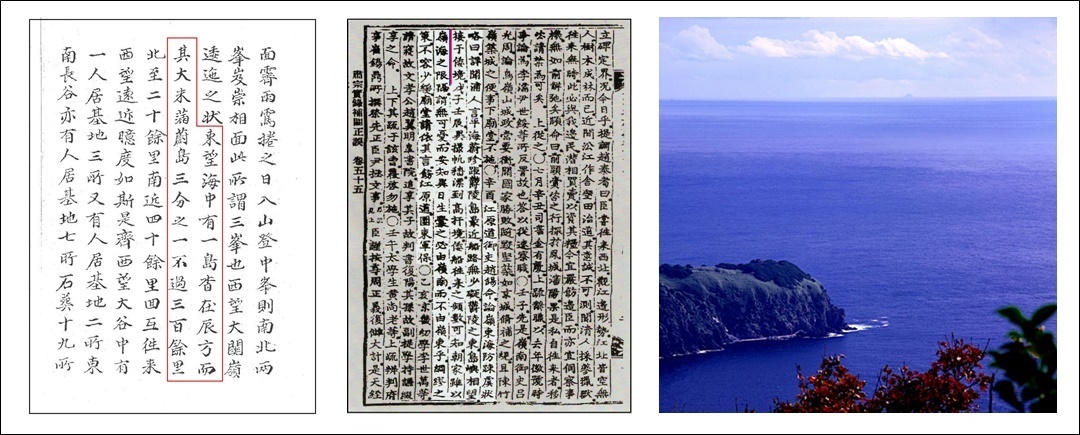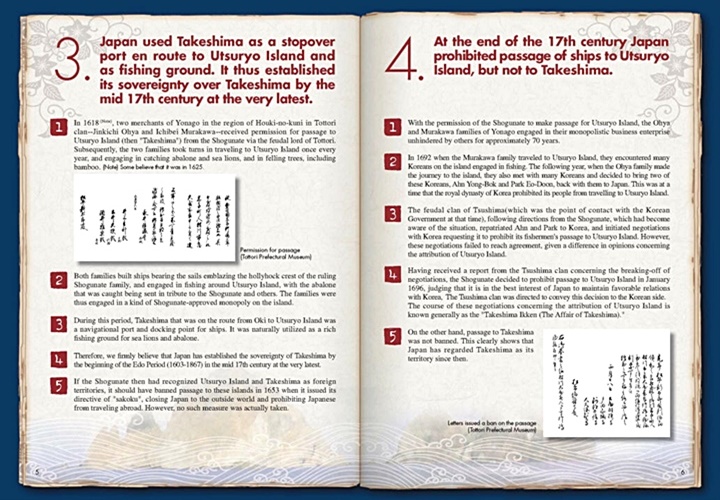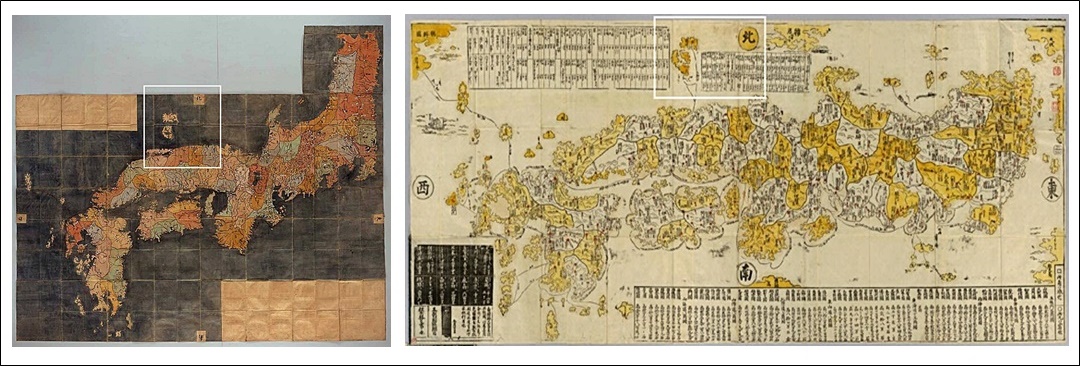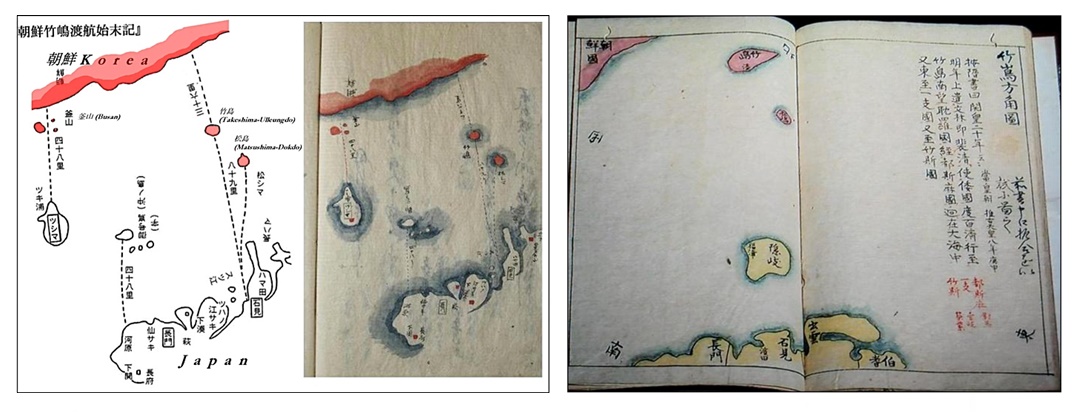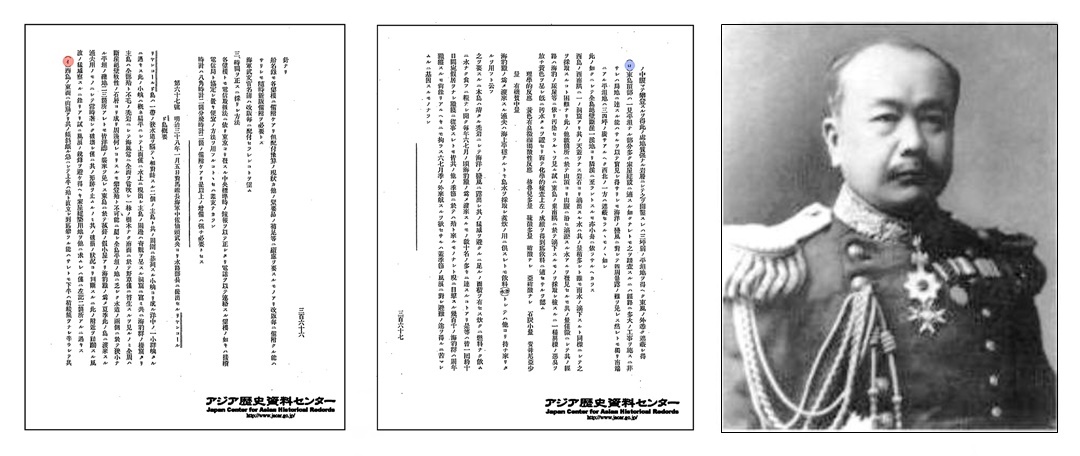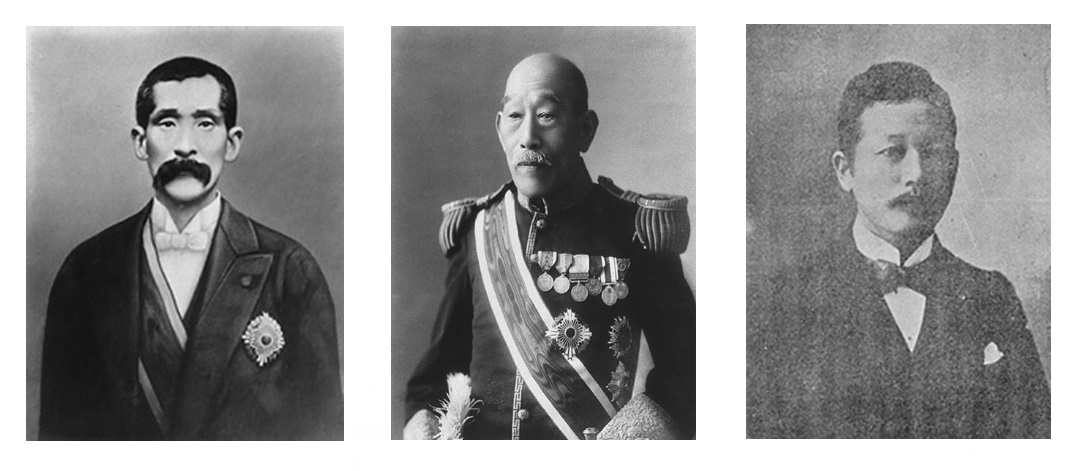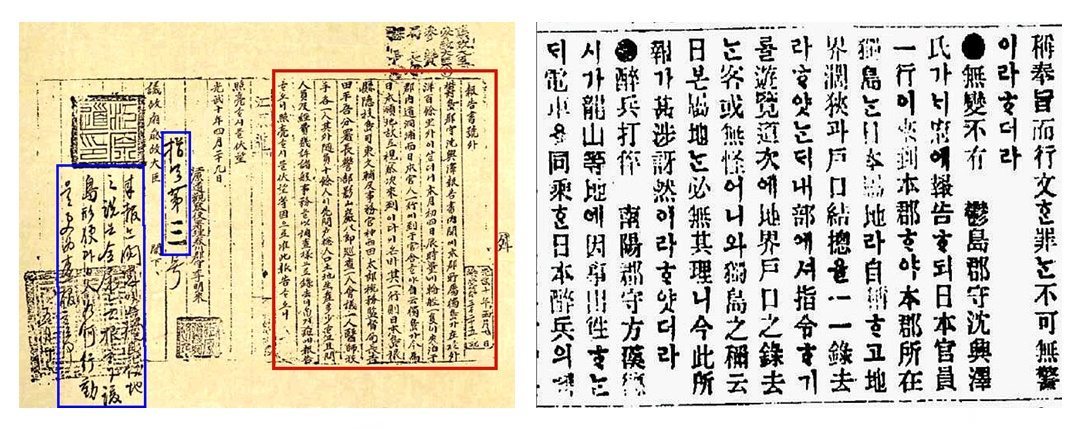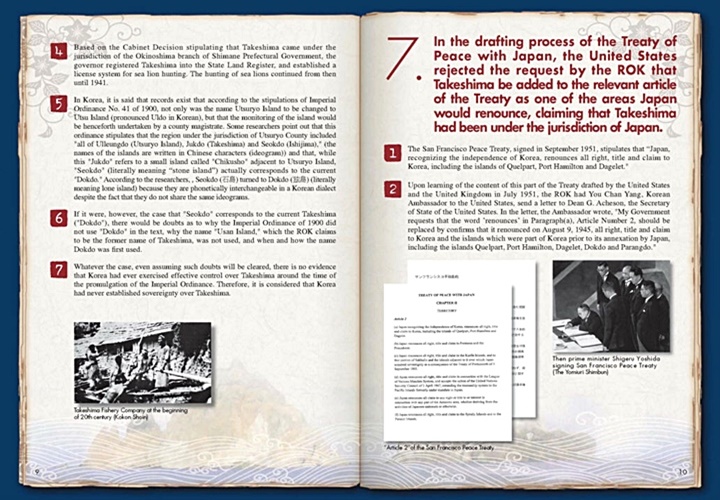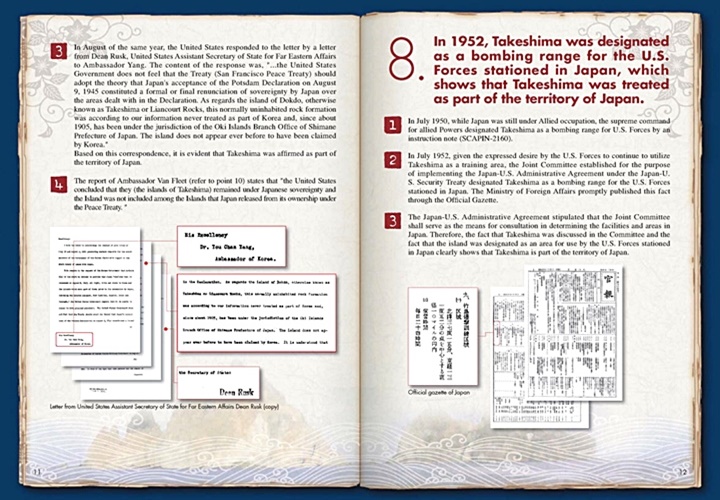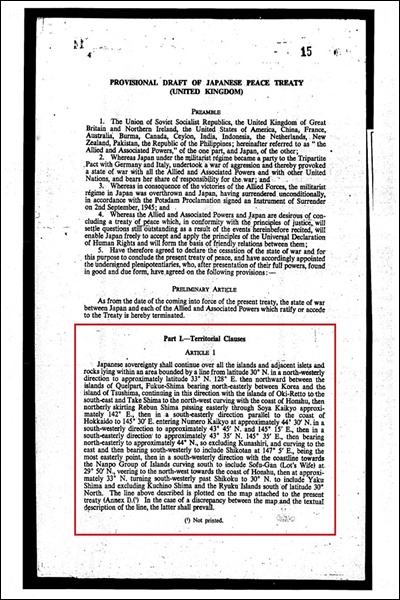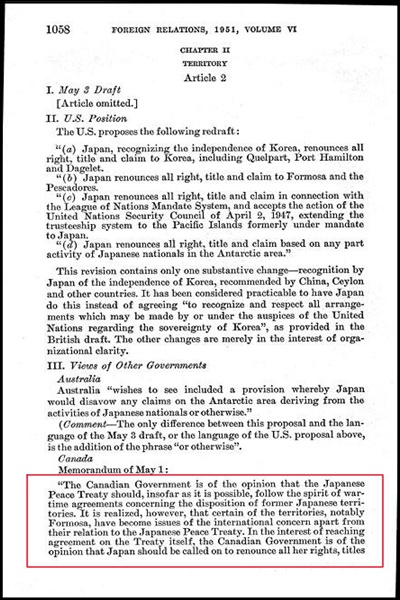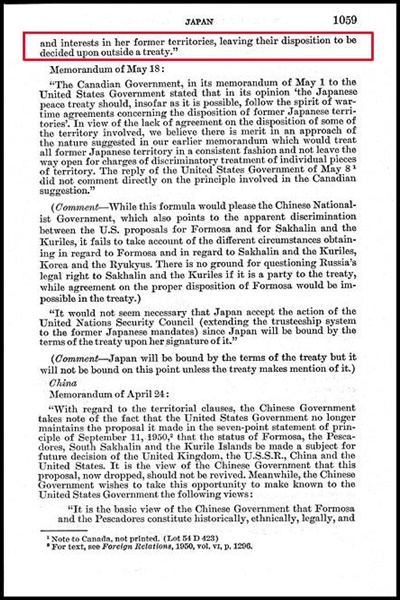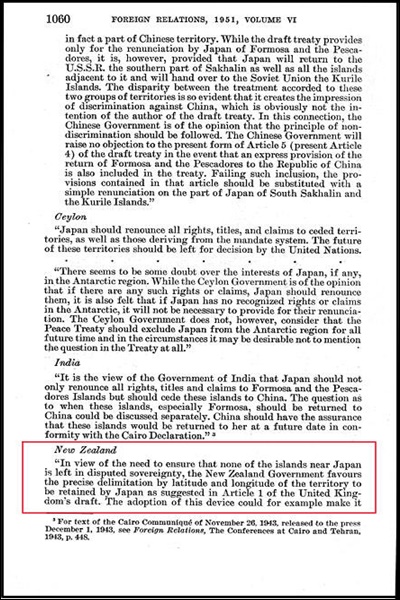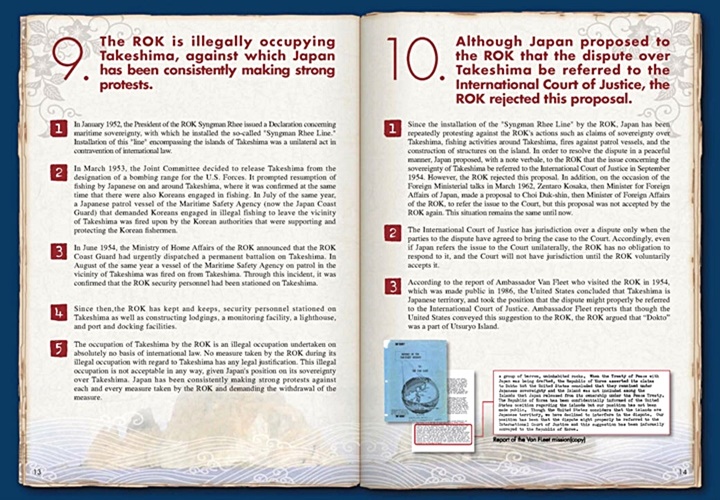Ancient Korean artifacts from the Unified Shilla Era (669-935 A.D.) found on Korea’s Ulleungdo Island, are proof of Koreans living within visual distance of Dokdo a thousand years before Japanese arrival in the area around 1618.
One clear example proving Chosun cognizance of Dokdo, a Korean inspector named Jang Han Sang recorded seeing Dokdo from Ulleungdo’s Seong In Bong Mountain in 1694. In the Ulleungdo Sa-Jeok (link) is written.
“…Looking toward the West, we could see (Korea’s) Dae-Gwal Yeong mountain range on the horizon. Toward the East, in the middle of the ocean, an island was vaguely visible to the east-southeast (辰方). It is not quite one third the size of Ulleungdo and only 300 ri away…”
In must be noted, although Jang Han Sang wrote he saw Dokdo on page 5 of his report, he later goes on to say he did not see any part of Japan. This proves Koreans of the day considered Dokdo within the realm of Korea and separate from Japan.
Later, in 1714 yet another Korean record states “…Gangwon Provincial emissary Jo Seok-myeong (趙錫命) discussed the neglected coastal defenses in the Yeongdong region. Here is a summary: “…I listened carefully to the people in the ports (浦人) who said, “Pyeonghae (平海) and Uljin (蔚珍) are closest to Ulleungdo, and there are no obstructions along the sea route. Visible to the east of Ulleung is an island that borders on the limits of Japan…” This record is evidence not only the Korean government was cognizant of Dokdo, but also Koreans who lived in coastal areas were aware of the islands. It’s worthy to note, these Koreans also describe Dokdo as near the limits of Japan and not part of Japan.
The images (left) above are very old Korean documents that record Dokdo’s visibility from Ulleungdo. Contrary to Japan’s MOFA’s brochure, Koreans were quite aware of Dokdo Island a very long time ago. Above right is a recent photo of Dokdo from Korea.
Japan’s MOFA has some basic facts right, however they then attempt to take these records a step further and stretch the truth. During the 17th Century the families Murakawa and Oya voyaged (illegally) to Chosun’s Ulleungdo Island (Utsuryo) Japan’s MOFA states “We firmly believe Japan had established the sovereignty of Takeshima by the beginning of the Edo Period (1603~1867) in the mid-17th Century at the latest…”
In the late 17th Century the Shogunate inquired about the territorial ownership of both Utsuryo (Ulleungdo) and Matsushima (today’s Dokdo) Here it was clearly stated both Ulleungdo and Takeshima were not part of Hoki or Imbashu disticts and thus not part of Japan. (see link) Yonago City in Hoki Prefecture was were all Japanese voyages by the Murakawas and Oyas originated from.
On December 24th 1695 Inaba and Hoki Provinces (Tottori) stated both Ulleungdo and Dokdo were not part of these provinces. From these documents it’s clear both Ulleungdo and Dokdo were not part of Japan during the 17th Century.
In the year 1667 a Japanese retainer of Izumo, named Saito Hosen issued a report on the Oki Islands on Japan’s West coast. Within this document it was declared the Oki Islands marked the boundary of Japan. (see link) This historic evidence can be supported by many Japanese maps of the 17th Century that not surprisingly also show Oki Islands as the northern boundary of Japan.
Japanese Maps of the 17th Century Omitted Dokdo Island
Above top: An 1686 map of Japan showing the Oki Islands as the limit of Japan. Above left: A 1654 map of Japan that also excluded Dokdo Island. Above right: A 1630 map of Japan that omitted Dokdo Island. All 17th Century maps of Japan excluded Dokdo Island. (click images)
Japan’s MOFA Point 4. “At the end of the 17th Century Japan prohibited passage of ships to Utsuryo (Ulleungdo Island) but not to Takeshima (Dokdo) …”
Some important facts and records cast serious doubt about the inference Japan’s MOFA’s makes from the facts above. Japan’s relationship with Dokdo throughout the 17th Century was only through her (illegal) activities on Korea’s Ulleungdo Island. Historically Japanese fishers recorded Dokdo Island as a distant, tiny, barren rock two and a half days away, against both prevailing winds and currents. Not one record exists of Japanese voyages to Dokdo as a sole destination. When Japan “acquiesced” to Korea confirming Chosun’s title to Ulleungdo Island, Japan’s necessity for Dokdo was naught. Japan‘s MOFA has deliberately misinterpreted the ommission of Dokdo from the Shoganate’s travel ban to wrongly assert this amounted to Japanese sovereignty over the islets. Is this a logical assumption?
A largely unknown, but significant event during the 19th Century sheds light on Japan’s Shogunate’s true policy regarding Matushima (Dokdo). In 1836, a Japanese travelling merchant named Aizuya Hacheimon was caught trespassing on Chosun’s Ulleungdo. Ultimately. Aizuya Hachiemon was executed for his activities. The documents and maps from Aizuya Hachiemon’s trial clearly illustrate the Shogunate’s travel ban extended over Matsushima (Dokdo) as well as Ulleungdo Island, thus confirming Korean sovereignty. (see link)
Above left: This image above is divided with labelled map for reference on the left. The original is Aizuya Hachiemon’s map drawn during the investigation of his trespassing on Korea’s Ulleungdo Island (Takeshima 竹島). This map clearly shows Ulleungdo (竹島) and Dokdo (松島 ) as Chosun (Korean) land. Above right: Another map from the Aizuya Hachiemon case showing Dokdo as Korean (click maps)
Japan’s MOFA 2008 Takeshima Brochure Pages Seven and Eight
The Takeshima Incident of 1836 and Dokdo
The 1695 Bafuku Records and Dokdo
Japan’s MOFA point 5. “The disposition of An Yong Bok, on which the ROK bases its claim, contains many points that conflict with factual evidence. ..”
The point Japan MOFA makes above is weakly supported in by her four point “rebuttal” Most shockingly this brochure relies entirely on Korean records and choses to ignore the recently discovered (in 2005 )An Yong Bok records from Japan’s Murakawa Family archives. (see link)
Japan’s MOFA states there could be no Japanese on Ulleungdo in 1695 because the Shogunate had already issued a prohibition on travel there. Japanese records and maps show us their Oya and Murakawa families had zero regard for the travel bans declared by the Shognate. In reality, maps of Ulleungdo from these trespassers prove the Japanese Oya Clan et al continued to clandestinely invade the Korea’s Ulleungdo almost immediately after the Shoganate issued a travel ban in 1695.
Above left: An Yong Bok’s statement from the Japanese Murakawa documents record Usando was the island called Matsushima (Dokdo) and was part of Korea’s Gangwan Province. Above right: An Yong Bok’s chart of Korea’s Eight Provinces. Note 竹島 (Ulleungdo) and 松島 (Dokdo) are drawn as part of 江原道 (Korea’s Gangwando Province)
Rather than take an academic approach at determining the true historical, territorial perceptions of 17th Century Japanese and Koreans, Japan’s MOFA’s resorts to putting their spin on the legality or legitimacy of Ah Yong Bok’s claims. We do know with 100 percent certainty An Yong Bok personally voyaged to Japan and declared Ulleungdo (竹島) and Dokdo (松島) as part of Korea’s Gangwando Province 江原道. From these documented claims, the Japanese Shogunate offered no objections in the correspondence that followed. Japan’s MOFA nitpicks on minor inconsistencies of An Yong Bok’s records rather than address the glaring truths of these valuable historical documents.
An Yong Bok and Dokdo Takeshima Part 1
An Yong Bok and Dokdo Takeshima Part 2
Japan’s MOFA point 6. “Japan reaffirmed its intention to claim sovereignty over Takeshima by incorporating Takeshima (Dokdo) into Shimane Prefecture in 1905. ..”
Japan’s MOFA’s sanitized account of Shimane Prefecture’s 1905 annexation of Dokdo is a product of Japan’s shameful denial of past military aggression from her colonial-expansionist era.
Japan’s MOFA’s superficial explanation of the circumstances surrounding her annexation of Dokdo fails to mention Japan’s military ambition for the islets. Japanese military records from the 1904~1905 Russo-Japanese War reveal the Japanese Navy’s need for watchtowers on Dokdo was the driving force behind Japan’s incorporation of Dokdo. It’s an undeniable fact, Japan’s annexation of Dokdo was an inseparable part of her colonization process over Korea.
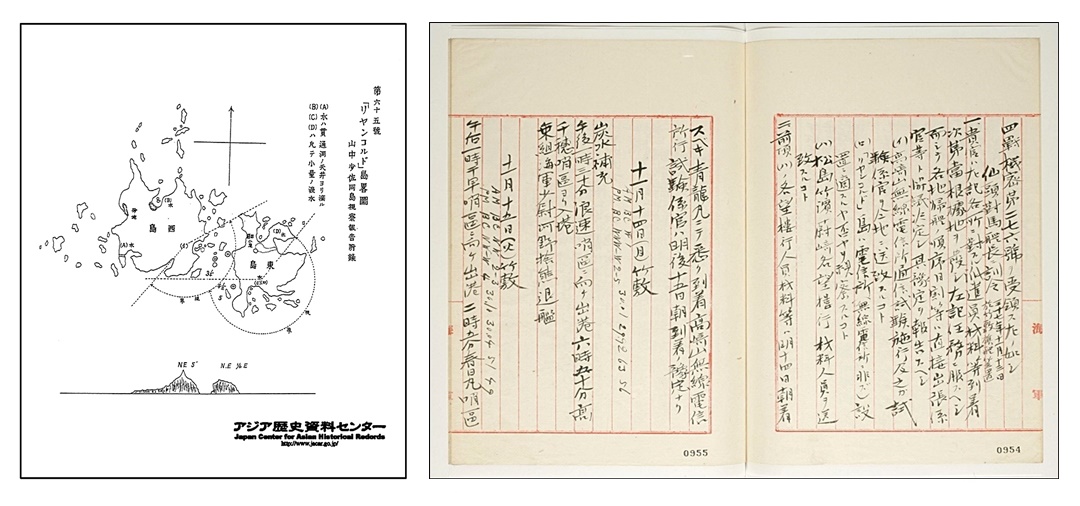
Above left: Three months before Japan incorporated Takeshima, Yamanaka Shibakichi of the Japanese Warship Tsushima drew this survey map of Liancourt Rocks. It shows ideal watchtower locations and visibility ranges. Above right: While in the process of installing military watchtowers on Korean land, the Japanese warship Tsushima’s logbook (above) records the command to survey Liancourt Rocks for telegraph installation on November 13th 1904, also three months before the island was annexed.
Read The Dokdo Takeshima X-Files Part 2 Here
On January 5th 1905, three weeks before Japan annexed Dokdo, the watchtower construction report from the Japanese Warship Tsushima was submitted to the Director of Japan’s Naval Hydrographic Department Kimotsuki Kenko. He was instrumental in guiding Nakai Yozaburo’s application to have Dokdo Island leased and annexed.
Above left to right: Komura Jutaro, Kiyourga Kiego and Yamaza Enjiro. These Japanese politicians were all staunch supporters of the colonization of Korea. They were also involved in forcing through Nakai Yozaburo’s application to have Dokdo annexed by Japan.
Japan did not “reaffirm its intention of claim Dokdo in 1905”, and it certainly was not “broadly publicized” at all. The Japanese Government clandestinely annexed Dokdo Island in a sub rosa cabinet meeting. This was without external notification beyond a minuscule ad on a second page of a local newspaper that didn’t even mention the island’s name.
Furthermore, the Korean government contested Japan’s annexation of Dokdo at different governmental levels and through local media immediately upon being informed in 1906. However, by this time, the Japanese had assumed control over Korea’s foreign affairs office.
The above records show that upon hearing Japan annexed Dokdo, Korea contested this action through both her government and media. At this point Korea’s Foreign Affairs Office had been dismantled starting in August of 1904.
Korean Protests to Japan’s Annexation of Dokdo Takeshima in 1906.
Japan’s MOFA 2008 Takeshima Brochure Pages Nine Through Twelve
Japan’s MOFA’s point 7 “In the drafting process of the Treaty of Peace with Japan, the United States rejected the request by the ROK that Takeshima (Dokdo) be added to the relevant article of the treaty as one of the areas that Japan would renounce, claiming that Takeshima had been under the jurisdiction of Japan…”
The negotiations involving the fate of former Japanese territories was a long, drawn-out process. The first five and seventh drafts of the treaty provided that Liancourt be given to Korea by including the islets in the Article 2 (a) list. The sixth, eighth, ninth, and fourteenth drafts explicitly stated that the territory of Japan included Dokdo Takeshima. The tenth through thirteenth and fifteenth through eighteenth drafts, like the final draft, were silent on the status of Dokdo Takeshima
Japan’s MOFA (not surprisingly) makes no mention that early drafts granted Dokdo to Korea, later drafts omitted the islets, and most importantly the final draft of the Japan Peace Treaty made no mention of Dokdo Takeshima at all.
Images above: After five drafts of the Japan Peace Treaty renouncing Dokdo Takeshima to Korea, the U.S. government suddenly reversed this decision and decided Japan should have the islets. This was only days after General MacArthur recommended military joint trusteeships for bases should be implemented in tandem with the San Francisco Peace Treaty.
Japan’s MOFA’s point 8 “In 1952, Takeshima was designated as a bombing range for the U.S. Forces, stationed in Japan, which shows that Takeshima was treated as part of Japan…”
Issues 7 and 8 raised by Japan’s MOFA are based on reckless conclusions drawn from confidential memorandums exchanged between American Forces and Japan/Korea. None of these secret records ever materialized into the U.S. Government’s open and public support for Japan’s title to Dokdo Takeshima
Above: The documents above record that not all Allied Countries agreed with America’s decisions regarding the disposition of former Japanese territories. This would have excluded Dokdo Takeshima from the definition of post WWII Japan
Japan’s Ministry of Foreign Affairs wrongly asserts the American government was empowered to define the territorial limits of Japan. Post WWII decisions had to be approved by Allied Command NOT only the U.S. About 48 countries were involved in the negotiations of the Japan Peace Treaty. Related historical records from Japan’s post WWII peace treaty show that other nations (Canada, Russia and New Zealand) preferred to follow the definition of Japan as outlined in wartime agreements such as the Potsdam Declaration and the Cairo Convention. This would have left Dokdo Takeshima out of Japanese territory. This explains why no final agreement could be reached on the fate of other former Japanese outlying islands. In short, the ommission of Dokdo Takeshima from the Japan Peace Treaty cannot amount to Japanese sovereignty over the islets.
Here again, historical context is important. During the drafting process of the Japan Peace Treaty, U.S. Military brass were drafting joint security arrangements with Japan allowing U.S. forces to be stationed on former Japanese outlying islands. Records show the U.S. military hoped to acquire the rights to install weather and radar bases on Dokdo Takeshima. Obviously, America’s decisions during the deliberation process were tainted by her need to militarily posture for the Cold War Communist threat. Clearly, U.S. decisions as to territorial ownership of Dokdo Takeshima were military judgements, not determinations based on a true historical study of the islets.
At the very least, because the Korean government was neither participatory nor signatory to the Japan Peace Treaty, it has no real legal effect on the Republic of Korea at all.
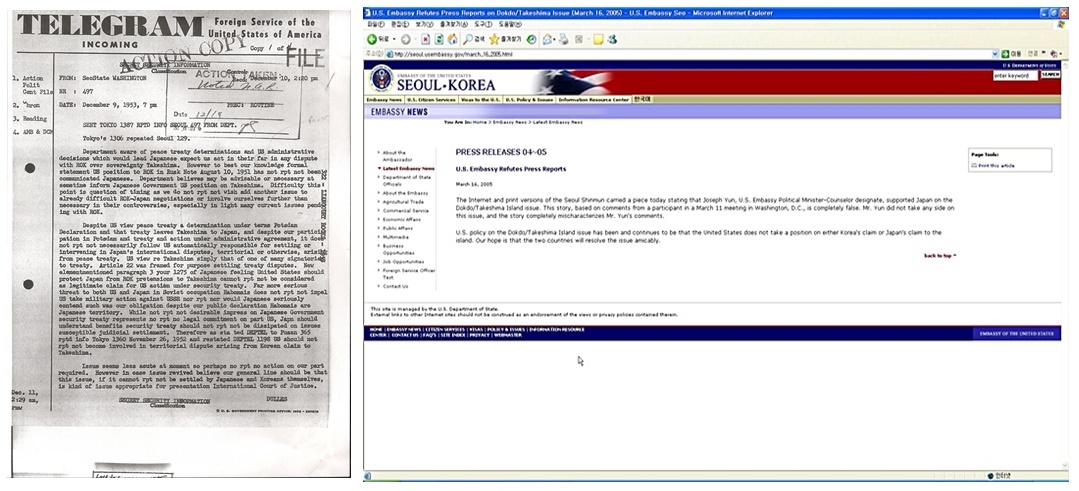
Above left: This U.S. Government document records how America refused to support Japan’s claim to Takeshima. The image above right is from the American Embassy in Seoul reiterating America’s official position past and present. The U.S. has been and remains neutral on the issue of Dokdo Takeshima. (click twice for larger images)
Dokdo Takeshima and Post WW2
Dokdo Takeshima and the Japan Peace Treaty
Japan’s MOFA 2008 Takeshima Brochure Pages Thirteen and Fourteen
Japan’s MOFA’s point 9: “The ROK is illegally occupying Takeshima, against which Japan has been consistently making strong protests…”
Japan’s MOFA’s point 10: “Although Japan proposed to the ROK that the dispute over Takeshima be referred to the International Court of Justice, the ROK rejected the proposal…”
The last two points are little more than the obligatory rhetoric of Japan’s Ministry of Foreign Affairs that are hardly worthy of rebuttal. However, these issues should be briefly touched upon.
Japan’s MOFA asserts Korea is illegally occupying Takeshima. But even by their own admission this is “their given stance” or opinion. Japan’s definition of international law doesn’t create international conflicts to be resolved by the ICJ. Currently Japan and Korea have diplomatic offices and relations in place for solving such matters. Korea feels the Dokdo Takeshima dispute is a matter to be dealt with bilaterally not by foreign organizations.
Korea’s refusal to have the Dokdo-Takeshima case dealt with by the ICJ does not mean she feels her case is weak. It also doesn’t make the ROK some kind of rogue state. Having been occupied by Japan since 1904-1945, and been frozen out of post World War II Allied negotiations, the ROK wishes to play a pivotal role when dealing with her territorial issues. This is especially true when the dispute involves geographic regions that would ultimately define the ROK’s national boundary.
Japan admonishes Korea for not allowing the ICJ to arbitrate the Dokdo Takeshima. This is quite hypocritical given the fact Japan refuses to allow the ICJ resolve her ongoing border dispute with her other neighbours such as China.
In conclusion, Japan’s MOFA’s 2008 ’10 Issues of Takeshima’ brochure fails to deliver. It’s a collection of poorly-researched, incomplete, historical documents that are easily refuted by citing primary Japanese-Korean records and maps. Japan’s MOFA’s feverish lobbying for Takeshima is simply not enough. If Japan wishes to garner both domestic and international support for her claim to Dokdo Takeshima, she must present a far more convincing case.

